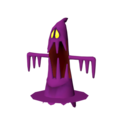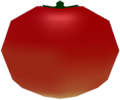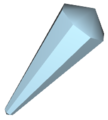List of Luigi's Mansion pre-release and unused content
It has been requested that this article be rewritten. Reason: it's poorly worded, not sourced properly and needs to be organized as indicated on MarioWiki:Pre-release and unused content
This is a list of pre-release and unused content for the game Luigi's Mansion.
Early ideas
Different kinds of houses were proposed for the game, including an apartment complex, a dollhouse, a 'ninja mansion', a Japanese-style house, and a prarie and desert level using a Mario theme. The game was originally conceptualized to resemble the Mario series more closely, but strayed when the haunted western mansion concept took priority.[1]
Luigi's Mansion was originally built with the intention of being in stereoscopic 3D. The GameCube was built with 3D components which could be activated by an unreleased add-on.[2] This add-on was never released as its price would have been far greater than the console. Another unreleased add-on would have allowed the Game Boy Advance to be used as an external controller in conjunction with the game.[3]
Early iterations
Concepts for Luigi's Mansion, such as character designs, were being planned during the Nintendo 64's lifetime.[1]
The game was first revealed at Nintendo Space World in 2000 as a Tech Demo, designed to show off the graphical capabilities of the Nintendo GameCube.[4][5]
Nintendo then decided to make Luigi's Mansion into a full-fledged game, and was later showcased at E3 in 2001, with notable changes to the design of the disc.[6][3]
Early builds
Old issues of Nintendo Power (pictured below) contain details of early elements in screenshots and descriptions.
Poltergust
In earlier builds, the Poltergust 3000 originally featured a pressure meter ranging from one to ten, and was slightly bigger.[6] If the pressure meter reached ten, the vacuum would burst into flames, causing Luigi to fall over and lose health, his HP eventually raises back up slightly after a while.[6] Earlier versions of the game allowed Luigi to spray water. [3] The Poltergust 3000 also had different nozzles depending on what element was being used.[7]
GUI changes
Luigi's total remaining health was shown as a fraction.[3] Coins also had their own meter.[3]
Originally, the Game Boy Horror had an LCD border, which would function as a red flashing radar to show Luigi the locations of both ghosts and Boos within a room, and had a clock function.[3] One clip shows that once the clock reached 1:30 on the E3 Nintendo Booth version, E. Gadd would contact Luigi and send him back to the title screen.[8] Early gameplay images reveal that instead of showing Luigi his current gold total, the Game Boy Horror would always display a first-person view camera, giving the player two perspectives in a room at once. It was cut due to the Nintendo GameCube's hardware not being able to handle it. [9]
Model changes
There are three renders of Luigi left in the code for the ending, each with a varying degree of happiness. The renders are a depressed Luigi holding a flower (worst), a pleased Luigi with a peace sign (good), and another pleased Luigi with two peace signs (best).[10] An unused model for Mario, named "bmario", is stretched to Luigi's proportions and given the backstraps for his Poltergust 3000, possibly suggesting that Multiplayer was a thing originally. [7]
Cyan and blue-colored Shy Guy Ghosts are also in the game's coding.[10]
In the game's coding is also the unused Poltergust 3000, along with two unused nozzles; one is labeled "wpwater" and appeared when Luigi used the water element,[3] and one is labeled "wpair".[7]
One unused model is the elh. It is a twisting creature that has no textures or any UV maps that would support textures, and, according to its entries, it was compiled a month after Luigi's Mansion was featured at E3 2001. It has six animations for various states (attacking, taking damage, two idles, alert, and developing), and has four particle effects associated with the Elements Luigi uses.[7]
There is an unused model of a Phonograph left in the Projection Room's files. The model shows a small table holding up the Phonograph, a record that spins with the Phonograph, and has a golden look to it. It comes with two animation files that are names similar as to the Projector's animations. (File located at: "root\Iwamoto\map2\room13.arc\chiku.bin") [11]
Early ghosts
- There were ghosts in earlier versions that were similar in appearance to Gold Ghosts. They would attack Luigi from behind by going "BAAHHHHH!", causing Luigi to scream, crawl backwards uncontrollably, and lose half his HP. Luigi's HP raises back up after a while and his heart would beat fast on his health gauge.[3]
- In earlier versions of the Kitchen, a ghost resembling a chef would have appeared while holding a tomato.[12]
Other
- The game had a different main menu, giving the options to "Skip Intro," or play "From The Beginning."[3] E. Gadd also had different dialogue.[3]
- The cutscene showing Luigi walking to and opening the door to the mansion was slightly different.[3] The door was also designed differently.[3]
- Ghosts had a different sound effect when appearing upon from behind the player, instead of the final scary, loud scream from behind in the final. Ghosts also didn't startle Luigi upon appearing.
- There were two unused early ghost designs[10]:
- A blue ghost (thought to be an early Gold Ghost)
- A green ghost (thought to be an early Purple Puncher)
- There were four unused dialogue icons:[10]
- Bowser
- Green Toad
- Gold Ghost
- Mario
- There were four unused text strings suggesting that E. Gadd's Lab was once explorable. (The Gallery is explorable but its associated area text seen upon entrance is unused.):
Media
Gallery
Artwork
- Professor Elvin Gadd.JPG
An early Poltergust 3000 on Professor E. Gadd's back.
Screenshots
Spaceworld 2000
- Beta Mansion.png
An early version of the Mansion.
- Beta Ghosts Surround Luigi.png
Unused blue ghosts surround Luigi.
- Two Ghosts Cupboard LM Beta.jpg
Two ghosts hide behind a cupboard.
- Beta Poker 2000.jpg
Oddly enough, three blue ghosts appear in the Parlor for roughly a second.
Bold text==== E3 2001 ====
- Beta menu.png
A different main menu.
- Luigi Screams in LM Beta.png
From a cut FMV. This could possibly be for an unused sequence. Luigi looks at the viewer, breaking the fourth wall.
- Beta Parlor 1.jpg
A very early Parlor. Filled with many assets of furniture, most of which don't appear in the final game.
- Beta Foyer.jpg
Luigi entering the Foyer, originally called "Entrance".
- Beggining intro.jpg
Luigi opens the entrance door differently.
- Beta Foyer 1.jpg
An early Foyer, this version of the Foyer can still be seen if the player presses start/pauses the game.
- Beta Game Boy Horror.jpg
The Game Boy Horror was originally just called a Game Boy Color.
- Pinkghost.jpg
The early white ghost or "Basher".
- Luigis19.jpg
An early version of Chauncey's room.
- Luigibusters42 640w.jpg
An early screenshot with the heat meter and a different Game Boy Horror. Note: an extra side-chair.
- Luigis14.jpg
A screenshot of an upset Luigi the end of the E3 2001 trailer. It's purpose is unknown, but it is most likely a beta Game Over screen.
- Sitting room no cloth on table.jpg
There's no cloth on the table.
- Beta basement.jpg
An early, entirely different basement.
- LM1.jpg
Dark Purple "Basher" in a completely different Master Bedroom layout.
- LM2.jpg
A maroon-colored "Basher" scares Luigi.
- LM3.jpg
A "Basher" scaring Luigi, again.
- LM4.jpg
A possible Chef Ghost with the unused tomato.
- Parlor Beta.png
Early Bashers, along with ghost portraits on the wall.
- Beta Parlor.jpg
The Parlor was originally named "Living Room".
- Beta LM disc.jpg
The Luigi's Mansion disc, shown at E3 2001, has a different label than the retail's.
- Beta LM disc 1.jpg
Satoru Iwata holds a Luigi's Mansion disc.
Game Boy Horror build
- LM Beta Foyer GBH.png
Luigi uses his Poltergust 3000 on the Foyer's chandelier.
- Kitchen LM Beta.png
Luigi in the Kitchen.
- LM Luigi Boo Beta.png
Luigi tries to capture a Boo in the Study.
- Garbage Ghost Beta.png
An early version of the Wardrobe Room.
- Beta Balcony.png
Luigi outside on the Balcony in one early build.
- Beta Conservatory.jpg
Notice there are instruments on the wall, along with steep steps for Luigi to walk on.
- Rec room.JPG
An early version of the Rec Room.
- Safari room.JPG
The tiger mats aren't on tables in the final version.
- Lmbetathing.jpg
The Game Boy Horror showing what Luigi is seeing without switching to first-person view.
Other builds
- Neville old IGN.jpg
A later build. Note, how the player has one Boo captured, however, this is possible only later in the game.
Scrapped features
The first unused version of the Gallery.
- LM Wpwater e3 ingame.png
Luigi using the Poltergust 3000's scrapped water nozzle.
- 3 Beta Ghosts.png
What appears to be the portrait of three early or cut ghosts, supposedly set to appear in the Parlor, on the Ghost Portrificationizer.
Models
- LM Unused Blue Vase.PNG
The blue vase seen in the E3 Demo footage. (The blue vase file can be found in the Luigi's Mansion first area hallway .arc files. root/Iwamoto/map2/room29.arc/tubo30_1.bin) [11]
- LM-Endingbad.png
The leftover "bad" rank.
- LM-Endinggood.png
The leftover "good" rank.
- LM-EndingrankA.png
The leftover "great" rank.
- White beta ghost.png
An early Basher.
- Orange beta ghost.png
An early Purple Puncher.
- Pink beta ghost.png
An early Blue Twirler.
- Beta King Boo.png
An early King Boo.
Unused Flying Fish models labeled "Ball".
- LM beta door.png
Unused door model.
Original Bogmire model, labeled "shadow".
- Ghost Beta Guy.png
Unused models for blue and cyan variants of the Shy Guy Ghost.
The phonograph.[11]
The Bat Twirler, which would likely have been used for The Twins' Room.[11]
- LuigisMansion-Mario model.png
bmario, which shows a T-posed Mario and Luigi wearing Poltergust straps. Note that Mario is almost as tall as Luigi.
- LM beta Daisy.png
Artwork of Daisy from Mario Tennis, likely a test image.
Text strings
Scans
- LMNP1.jpg
A Nintendo Power magazine of Luigi's Mansion Pg. 36.
- LMNP2.jpg
A Nintendo Power magazine of Luigi's Mansion Pg. 37.
- LMNP3.jpg
A Nintendo Power magazine of Luigi's Mansion Pg. 38.
- LMNP4.jpg
A Nintendo Power magazine of Luigi's Mansion Pg. 39.
Trivia
- The Japanese version of the game kept Luigi's early or cut hurt sound, while US and European versions didn't.
- The Game Boy Horror's timer and first person view is still in the game's code and has been found and made into AR codes.
References
- ^ a b Calderon, Anthony (January 21, 2005). The Making of the Game - Luigi's Mansion. N-Sider. Retrieved November 29, 2014.
- ^ Edge Staff (July 7, 2010). Hideki Konno Discusses The 3DS. EDGE. Retrieved November 29, 2014.
- ^ a b c d e f g h i j k l Luigi's Mansion E3 2001 Tech Demo Show Off. YouTube. Retrieved November 29, 2014.
- ^ Nintendo Gamecube, SpaceWorld 2000. YouTube. Retrieved November 29, 2014.
- ^ Space World 2000 GameCube Movie Reel. YouTube. Retrieved November 29, 2014.
- ^ a b c Luigi's Mansion E3 2001 Footage. YouTube. Retrieved November 29, 2014.
- ^ a b c d Luigi's Mansion/Unused Models. The Cutting Room Floor. Retrieved November 29, 2014.
- ^ Luigi's Mansion E3 2001 - Nintendo Booth. YouTube. Retrieved November 29, 2014.
- ^ Nintendo Power Vol. 149, page 36.
- ^ a b c d Luigi's Mansion/Unused Graphics. The Cutting Room Floor. Retrieved November 29, 2014.
- ^ a b c d Luke Dzamonja. (May 17, 2015). Unused LM BETA & Unused Content (With some hacks)., YouTube. Retrieved May 24, 2015.
- ^ Prelease screenshot of the mansion's kitchen.
- ^ File:Underground lab string LM.png
- ^ File:Gallery string LM.png
- ^ File:Training Room string LM.png
- ^ File:Portrificationizer Room string LM.png
External links
- Luigi's Mansion pre-release - IGN article
- Luigi's Mansion pre-release and unused content - The Cutting Room Floor
- Luigi's Mansion pre-release images - Freewebs
- Luigi's Mansion pre-release images - Gamespot pages 3-5
- Luigi's Mansion pre-release images - IGN pages 8-12
















![The phonograph.[11]](https://mario.wiki.gallery/images/thumb/8/85/LM_Unused_Phonograph.png/120px-LM_Unused_Phonograph.png)
![The Bat Twirler, which would likely have been used for The Twins' Room.[11]](https://mario.wiki.gallery/images/thumb/a/a7/Bat_Twirler.png/120px-Bat_Twirler.png)




